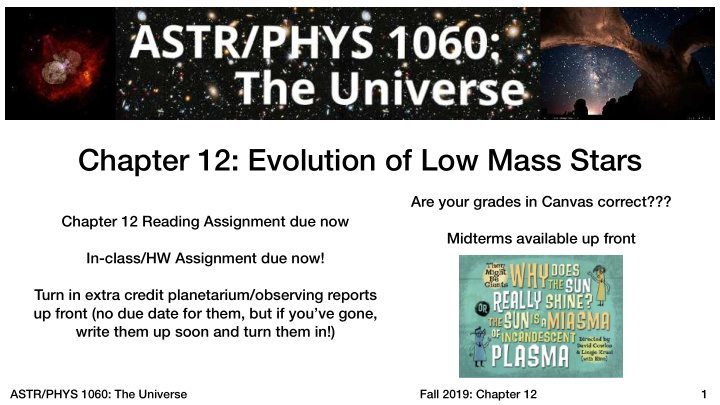



Chapter 12: Evolution of Low Mass Stars Are your grades in Canvas correct??? Chapter 12 Reading Assignment due now Midterms available up front In-class/HW Assignment due now! Turn in extra credit planetarium/observing reports up front (no due date for them, but if you’ve gone, write them up soon and turn them in!) ASTR/PHYS 1060: The Universe Fall 2019: Chapter 12 � 1
Stellar Properties Age Color Luminosity Which of these is most Spectral Type important? Mass Temperature Size ASTR/PHYS 1060: The Universe Fall 2019: Chapter 12 � 2
Stellar Properties Color Luminosity Mass Spectral Type Age Temperature Size ASTR/PHYS 1060: The Universe Fall 2019: Chapter 12 � 3
Luminosity depends on mass ASTR/PHYS 1060: The Universe Fall 2019: Chapter 12 � 4
Low High Mass Mass ASTR/PHYS 1060: The Universe Fall 2019: Chapter 12 � 5
Low High Mass Mass ASTR/PHYS 1060: The Universe Fall 2019: Chapter 12 � 6
ASTR/PHYS 1060: The Universe Fall 2019: Chapter 12 � 7
Why are fainter (and less massive) stars more common than brighter ones? A) They live longer B) They form more frequently C) They aren’t more common, we just see them more easily ASTR/PHYS 1060: The Universe Fall 2019: Chapter 12 � 8
The future of our Sun and the evolution of low-mass stars ASTR/PHYS 1060: The Universe Fall 2019: Chapter 12 � 9
Protostars to Stars ASTR/PHYS 1060: The Universe Fall 2019: Chapter 12 � 10
Lifetime as a function of mass ASTR/PHYS 1060: The Universe Fall 2019: Chapter 12 � 11
Main Sequence Power: Hydrogen Core Burning Temperature = 5800 K Luminosity = 1 L Sun Lifetime = 10 billion years ASTR/PHYS 1060: The Universe Fall 2019: Chapter 12 � 12
Red Giant Branch Power: Hydrogen Shell Burning Final Temperature = 3200 K Final Luminosity = 1000 L Sun Lifetime = 200 million years ASTR/PHYS 1060: The Universe Fall 2019: Chapter 12 � 13
Helium Burning or Horizontal Branch Power: Helium (into Carbon) Core Burning + Hydrogen shell burning Temperature = 4500 K Luminosity = 100 L Sun Lifetime = 100 million years ASTR/PHYS 1060: The Universe Fall 2019: Chapter 12 � 14
Asymptotic Giant Branch Power: Helium shell burning + Hydrogen shell burning Final Temperature = 3000 K Final Luminosity = 5000 L Sun Lifetime = 1 million years ASTR/PHYS 1060: The Universe Fall 2019: Chapter 12 � 15
Planetary Nebulae outer atmosphere ejected by radiation from the core ASTR/PHYS 1060: The Universe Fall 2019: Chapter 12 � 16
White Dwarf Power: None Temperature = 15000 K Luminosity = 0.001 L Sun Lifetime = 1 billion years (to cool down to ~7000 K) ASTR/PHYS 1060: The Universe Fall 2019: Chapter 12 � 17
ASTR/PHYS 1060: The Universe Fall 2019: Chapter 12 � 18
ASTR/PHYS 1060: The Universe Fall 2019: Chapter 12 � 19
ASTR/PHYS 1060: The Universe Fall 2019: Chapter 12 � 20
ASTR/PHYS 1060: The Universe Fall 2019: Chapter 12 � 21
ASTR/PHYS 1060: The Universe Fall 2019: Chapter 12 � 22
Future Evolution of the Sun Again, this time with feeling! ASTR/PHYS 1060: The Universe Fall 2019: Chapter 12 � 23
Size changes along with temperature ASTR/PHYS 1060: The Universe Fall 2019: Chapter 12 � 24
The universe is about 13 billion years old. If I see a 0.7 solar mass star, what phase of A) Main Sequence evolution will it be in? B) Red Giant Branch C) Helium Burning D) Asymptotic Giant Branch ASTR/PHYS 1060: The Universe Fall 2019: Chapter 12 � 25
How do we know the different stages of a star's life? We obviously have not been observing stars for long enough to see it go through all the stages. ASTR/PHYS 1060: The Universe Fall 2019: Chapter 12 � 26
Star Clusters: stars of many masses born at the same time ASTR/PHYS 1060: The Universe Fall 2019: Chapter 12 � 27
Which of these star clusters is the oldest? A B C ASTR/PHYS 1060: The Universe Fall 2019: Chapter 12 � 28
Theory (red line) & Observations (white dots) We can make a model of any star based on its mass and age ASTR/PHYS 1060: The Universe Fall 2019: Chapter 12 � 29
D Which stars in C this cluster are the most B massive? A ASTR/PHYS 1060: The Universe Fall 2019: Chapter 12 � 30
Because stars in clusters form at the same time, and a star’s evolution is determined primarily by its mass, we can observe many clusters and figure out how stars evolve ASTR/PHYS 1060: The Universe Fall 2019: Chapter 12 � 31
What happens when close binary stars evolve? What is this??? ASTR/PHYS 1060: The Universe Fall 2019: Chapter 12 � 32
What happens when close binary stars evolve? ASTR/PHYS 1060: The Universe Fall 2019: Chapter 12 � 33
What happens when close binary stars evolve? ASTR/PHYS 1060: The Universe Fall 2019: Chapter 12 � 34
What happens when close binary stars evolve? ASTR/PHYS 1060: The Universe Fall 2019: Chapter 12 � 35
What happens when close binary stars evolve? ASTR/PHYS 1060: The Universe Fall 2019: Chapter 12 � 36
What happens when close binary stars evolve? A “nova” is what? A) Material from Star 2 hits the surface of the white dwarf, causing it to heat up B) Material from Star 2 accumulates on the surface until it’s hot enough to burn (fuse H -> He) C) Enough material falls on the white dwarf to cause the entire star to explode ASTR/PHYS 1060: The Universe Fall 2019: Chapter 12 � 37
What happens when close binary stars evolve? ASTR/PHYS 1060: The Universe Fall 2019: Chapter 12 � 38
What happens when close binary stars evolve? ASTR/PHYS 1060: The Universe Fall 2019: Chapter 12 � 39
Type Ia Supernovae ASTR/PHYS 1060: The Universe Fall 2019: Chapter 12 � 40
Recommend
More recommend